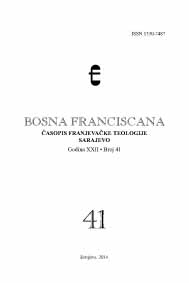Slavenska varijanta feudalizma (analiza na primjeru bellatores bosanskog srednjovjekovlja)
The Slavic variation of Feudalism (Analysis of the example of bellatores in Bosnian medieval history)
Author(s): Dženan DautovićSubject(s): History
Published by: Franjevačka teologija Sarajevo
Keywords: Bosnian medieval nobility; East-Central Europe; Myth of feudal anarchy; Historiography; everyday life; Regional identity.
Summary/Abstract: In this essay diferent aspects of nobility in medieval Bosnia are analysed, with one essential goal: to put it in context with the nobility in different parts of the known world, specifi cally in East Central Europe. Through this entire essay, the method of comparison has been extensively used, and has proven very effective. A somewhat controverisal headline was chosen because it provides clear and concise review of the main topic of this essay – nobility as part of feudal hierarchy, and also specifies the main historical region of the essay – East-Central Europe with dominant Slavic ethnic element. The analysis of the main features of nobility, as well as of the various activities they exercised daily, indicates that the nobility of Bosnian kingdom acted with the same principles of conduct as theirs counterparts throughout Europe, which once again proved that medieval Bosnia was a part of the East-European civilisational circle. Precisely these principles of conduct and the constant aspiration for as much political power and wealth as possible, can be found in the every corner of societies built on the Three estates (classes) model. This gives us the foundation to primarily identify, and then to try to challenge the allegations of the myth of feudal anarchy in medieval Bosnia, which supposedly erupted right after the death of king Tvrtko I (1391.) and evenutaly caused a breakdown of Bosnian kingdom long before the Ottoman conquest of 1463. by simply comparing the actions of bosnian nobility with procedures in Czech, Polish Hungarian, and other states. We came to conclusion that nobility in all of these countries acted in the same way. They equally strived for greatest possible autonomy and freedom but always within well known social boundaries. The borrowing of the research method of local identities from Geohumanistic science gave us an additional tool for disputing the beforementioned myth. It proved that, in case of Bosnian nobility, we can discern all three aspects of this identity: cognitive, affective and instrumental, and therefore in our opinion strenghten the thesis that the Bosnian medieval society was systematically arranged, and that inside this framework of arrangements all the dynamics of the very intricate relationships within the estate (class, rank) bellatores of Bosnian medieval period took place.
Journal: Bosna Franciscana
- Issue Year: 2014
- Issue No: 41
- Page Range: 133-165
- Page Count: 33
- Language: Croatian
- Content File-PDF

